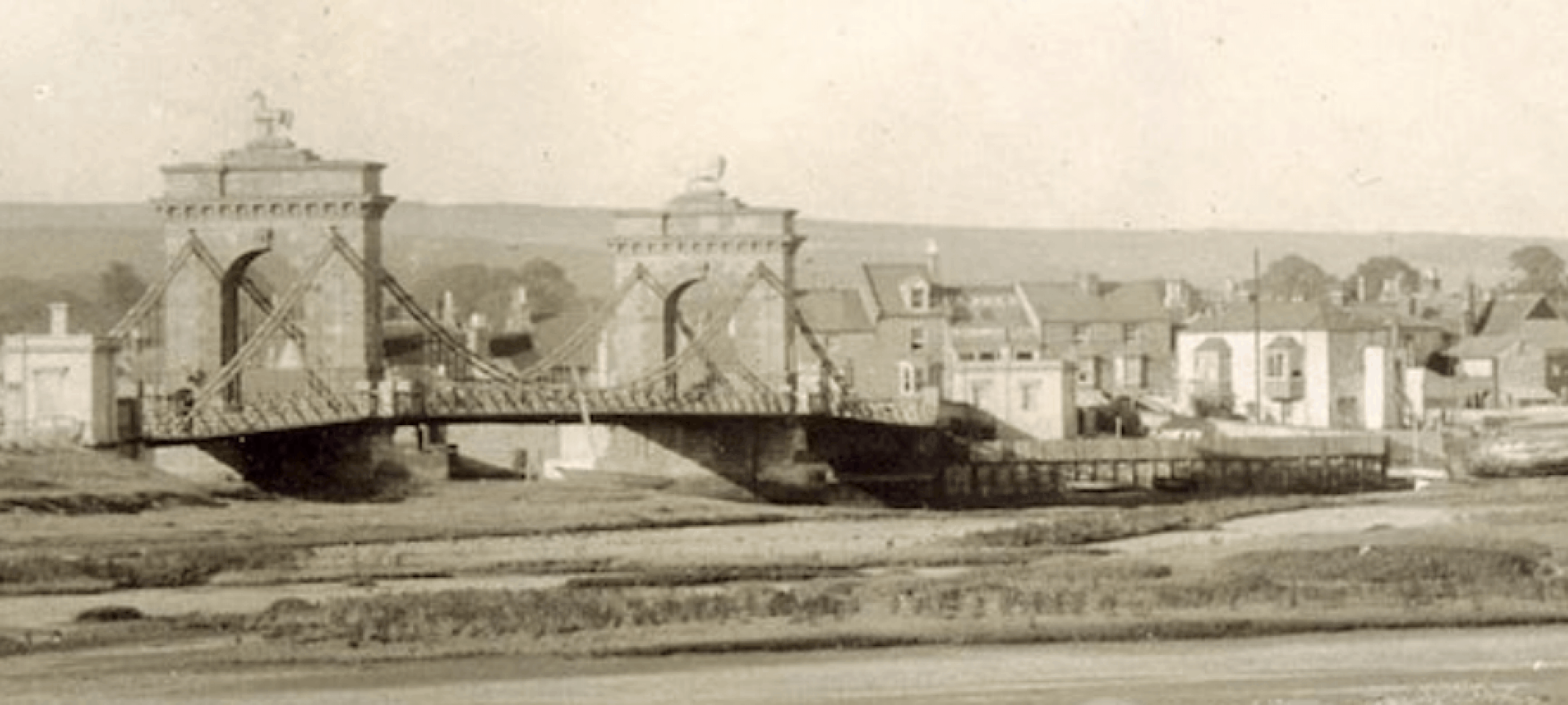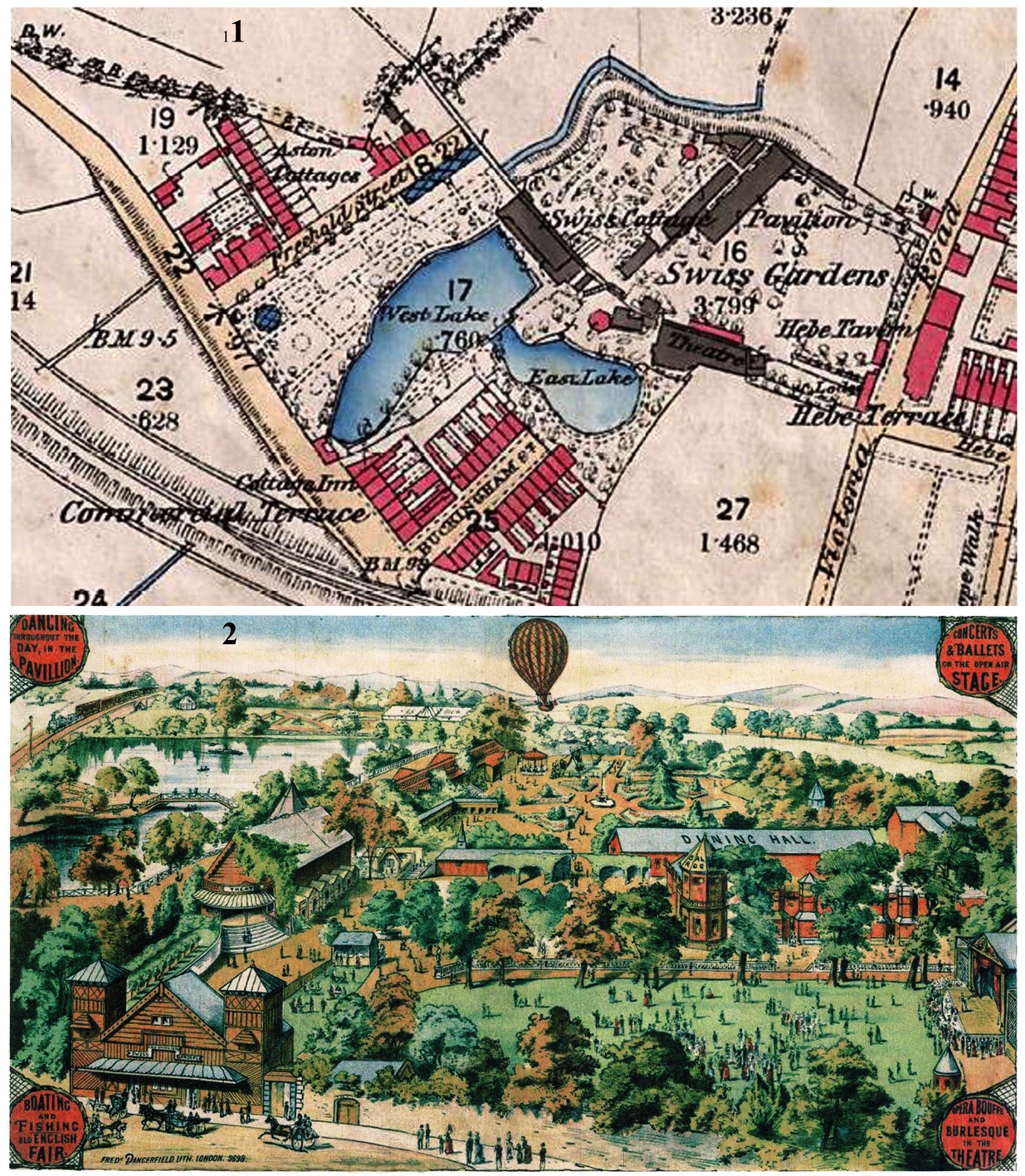Swiss Gardens in 1858
Shoreham’s Swiss Gardens as described in its heyday including the delightful sketches made at the time supplemented by further images from the collections of the Shorehambysea.com web site. The anonymous author of this article writes in typical Victorian journalese that is seemingly influenced by Charles Dickens’ comic descriptions of people and their names. He (the author) pokes fun at the people visiting the gardens (e.g., the British Sweetheart and his Adored One), the buildings and exhibits (the observatory looking like a “Brobdignagian wheat sheaf or stack of scaffold poles”; a museum of mixed early English with railway station architecture containing an uninspiring shark’s backbone and walrus tusk) but seems honestly impressed with other aspects such as the hot water laid on from spouts set into a wall, the slide shows, the commodious theatre and impressive gardens.
The beginning of this piece starts with Brighton but is also worth reading as it includes mention of Brighton personalities and places. It also includes an astute observation of the London trippers that came down by train for their day out looking for cheap entertainment (a description that rings true even now) and ultimately finding this at Shoreham.
Roger Bateman
Shoreham
January 2012
THE SWISS GARDENS, SHOREHAM
from the Illustrated Times September 25th 1858
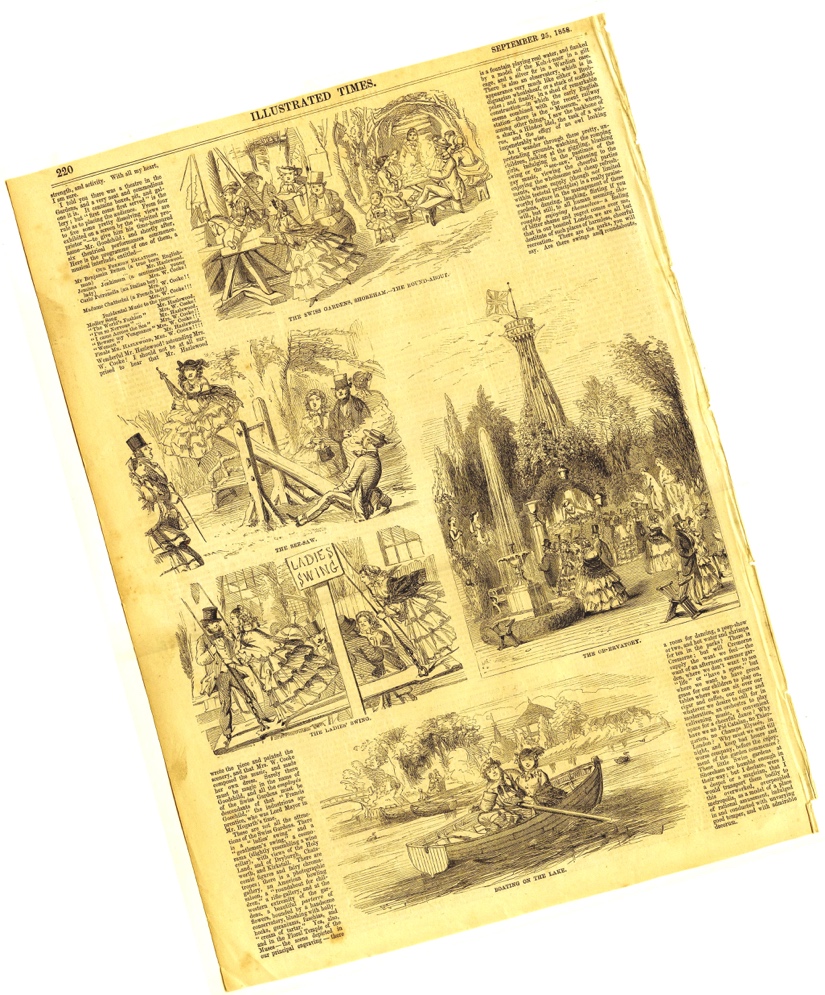
An old French traveller, who visited these isles about sanguinary Queen Mary’s time, I think, describes our people at their pastimes, as amusing themselves “sadly—tristement—as it is the manners of the English to do.” Now, after a lapse of three centuries, we are not the less open to the mournful impeachment. A”general holiday” in England is a most lugubrious affair. A public ceremonial has always something funereal about it, and leaves an uneasy impression that the body has been left behind; there is always a vast amount of weeping and lamentation at weddings and christenings: We have always a powerful party in the State striving to curtail the few remaining amusements of the people; and the career of the managers of most of our theatres and places of public recreation is a continuous struggle against chronic discredit and ever-impending bankruptcy.
No greater example could exist of the dearth of amusements which disrelish or prejudice or both have brought about among us than in the charming town of Brighton, a not only self-asserted, but world-confessed queen of watering-places. If this sparkling, salt-watery gem of a place, this villeggiaitura of all the world’s idleness, belonged to any foreign Power, it would be one of the gayest indoor and outdoor bains de mer in existence. There would be an opera-house and a vaudeville theatre ; a permanent wizard, a “Thiergarten,” a strangers’ club, a easino, a Kursaal or conversations-haus, a subscription ball-room, and, in its environs, a perfect cloud of, cafes, rustic chalets, strawberry and dancing gardens, with military bands.; gipsics’ tents, and Turkish kiosques, As to the Pavilion—but I am quite bewildered when I think of the galaxy of amusements that would irradiate that fantastic building under the auspices of a-French maire or a German burgomaster.
But we manage these things differently in England and at Brighton. We walk up and down the cliff, and bathe in the sea, and sometimes stare at each other through telescopes while we are taking our dip in the briny, a proceeding, not certainly very noisy, but, I think, somewhat naughty. We drive basket carriages, and amble on easy-going hacks under the stalwart riding-master’ wing. We go to the Puseyite church, and listen to the beautiful, beautiful Puseyite clergymen.
We eat pastry at Mutton’s; read the newspapers at Folthorpe’s (Mr. Hawkstonehengist, the man in the cloak who coughs continually—the “Lounger’,’ will remember him– is alive, reading the ” Morning Herald,” and coughing, to this day); we turn over the new ballads at Wright’s; stare at the nicknacks in Mr. Ambrossoni’s curiosity shops ; take pianoforte lessons from Madame d’Egville; sit under Mr. Paul Foskett occasionally, when that bread- brimmed apostle is more than usually incensed against the Scarlet Lady; we are rubbed by Mr. Harelip, and dosed by Doctor Cocklum; and send our boys to be crammed by Doctor Blimber, and our girls to be gentilisees by the Misses Berncastle. We (according to sex) -wear round hats, and, on windy days, are in sore distress about our ankles at, the corner of Ship Street, or stand smoking on the steps of the Old Ship, or catch colds in our heads among the damp woodwork underneath the pier; or pick up shells or crustacean with ugly names on the beach; or moon up and down the Marine Parade at night, trying to find out what the ” wild waves are saying.” In fact, we amuse ourselves in our sad, triste manner, just as the old Queen Mary’s traveller described us three hundred years ago; and we allow the cheerful,. pretty little theatre (with some few transient bursts of prosperity, such as the race week) to wither into a wilderness, saved only from being a howling one, by the patronage of the dragoon officers, who are such constant visitors that they must know every plank on the stage by sight.
That uncontrollable radical, however, the railway, has of late betaken itself to snatching up, every convenient fine day during the summer and autumn months, some thousands of troublesome people called excursionists, at London Bridge, and casting them out two hours afterwards close upon Brighton Beach. The conservative Brightonians don’t like these excursionists much: they accuse them of bringing down from town provisions in handbaskets and beer in stone bottles. They say that they craunch the beach to powder with their town-made Bluchers, and wear out the seats on the Esplanade. More than this, the railway brings down monthly and weekly hundreds of humble, middle-class families— rich in children, but somewhat pinched in pocket, who take cheap lodgings—houses even, sometimes—go to market for themselves, and enjoy the fresh, bracing air, the hundred healthful pleasures of the seaside, all at a desperately cheap rate, and to the great disgust of all true-blue Brightonians, whose ideas of a proper enjoyment of a marine residence are bound up in postchaises and four, wax candles, private rooms, bath- chairs, subscriptions to Folthorpe’s,. and guinea fees to the master of the ceremonies.
Now, these excursionists and cheap visitors come down to the queen of watering-places not only for health, but for some innocent amusement. The theatre is beyond their means—for the names of their children is legion; they seek in vain in Brighton for a place of recreation where they can do more than walk about; so, instructed by advertisements and placards, they betake themselves, by a five miles railway journey, to a pleasant little loophole of a port called Shoreham, where for the last twenty years have existed the Swiss Gardens, a very delightful establishment, which, ordinarily well attended during the week, is on Mondays and special “fete days patronised by an audience varying :from two to six thousand persons.
These pretty gardens (of whose varied attractions we this week engrave a series of characteristic sketches) are situated in a picturesque valley at the foot of the South Downs (0! muttony reminiscences!) just half way between Brighton and Worthing. The entrance is close to the railway-station, through a pleasant approach of plantations of forest trees and evergreens. Then you approach a handsome lodge, pay your shilling, take a check, pass through a turnstile, deliver your check at another turnstile, and after this you are free of all the amusements of the gardens.
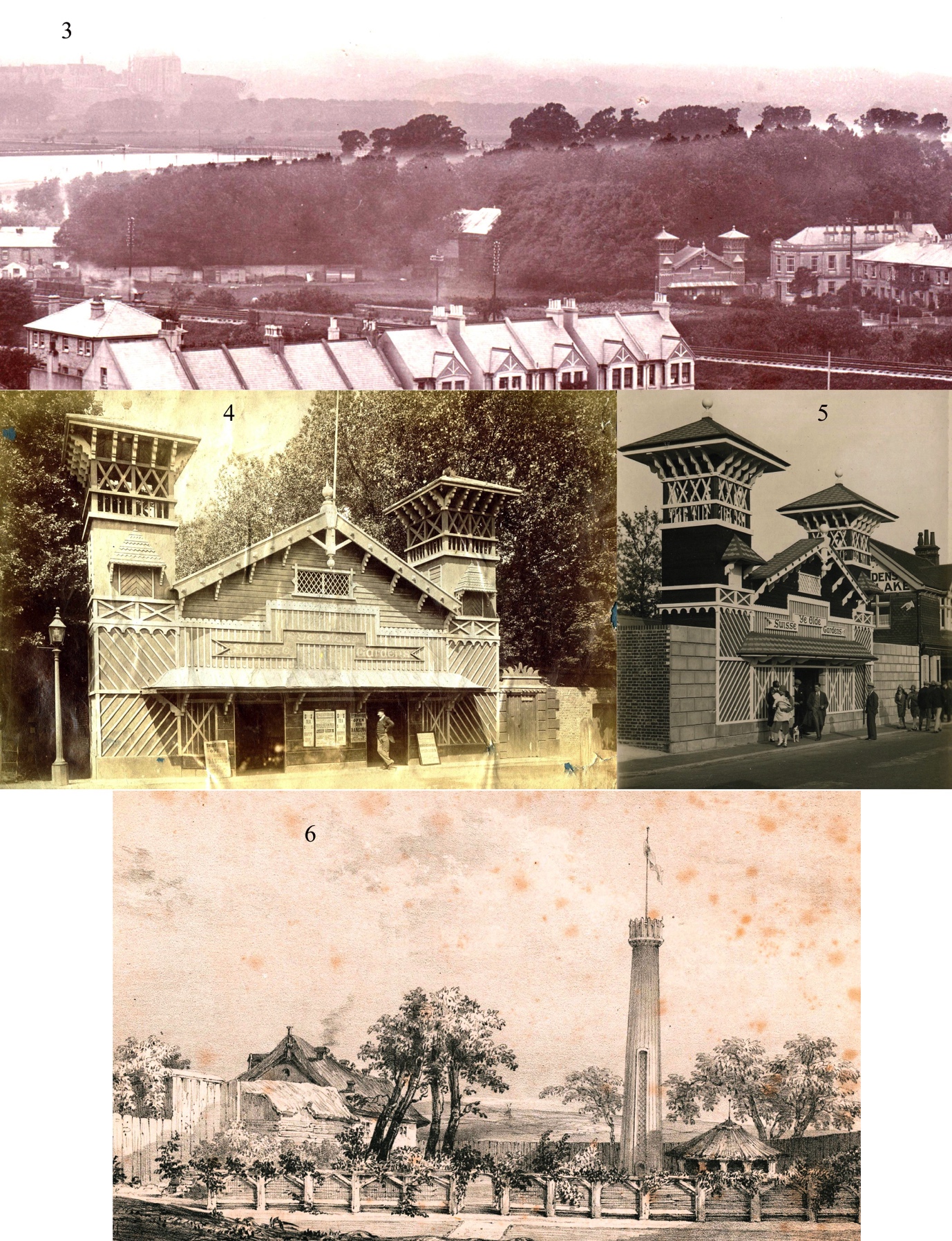
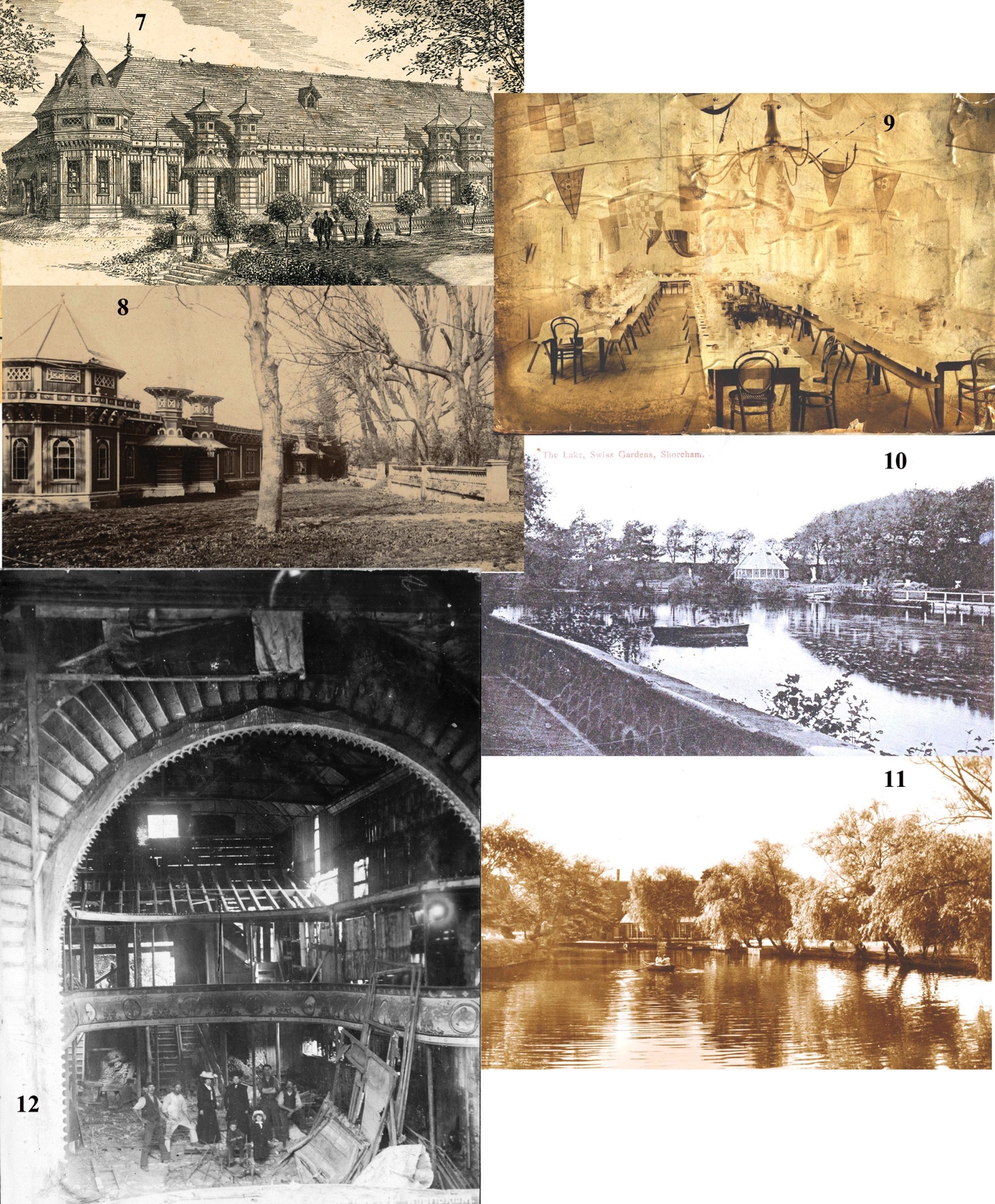
You may occupy any part of the spruce little theatre, from the private boxes to the gallery. You are entitled to witness the “Oracular, Aquatic, Terpsichorean, and Concertorial Entertainments,” as the bill sets forth, “without extra charge.” “Your hat is on and your house is covered; “it is not “sixpence here and sixpence there,” and you may wander at will among the varied attractions of the place, unless, indeed, you wish to engage a table for billiards, when a small sum is charged.
13. The East Lake and Temple
The only objection that can be urged against the Swiss Gardens is, that they are somewhat too “mazy.” The original space being.somewhat limited, and the liberal proprietor being constantly anxious to enhance the attractions of his entertainment and add to his bill of fare, the result has been that the gardens have assumed a guise between that of the Cretan Labyrinth and the Grotto of Aricia. There is a perpetual “getting up stairs” and going down them; and if unacquainted with the mysteries of the locality, or unaccompanied by a guide, you run the risk of finding yourself, after twenty minutes industrious strolling, at the place from which you started. Yet there is even some pleasure to be derived from this; you can’t lose yourself for long, and, as you wander through the little green mazes, ornamented with tasteful specimens of statuary (capitally selected, by the way, and the same forms of beauty and grace that rejoice us in the Crystal Palace), you are continually coming on fresh objects of interest.
This is a day as well as a night garden, be it understood. The proprietor does not entirely depend upon moonlight schottisches and polkas, nor on the radiant attractions of ” fifty thousand additional lamps;” and there can be few pleasanter sights than the crowds of happy children, disporting themselves on the velvet “meets” and among spangled flowers, clustering about the apparatus for gymnastic exercises, scampering up the innumerable flights of steps and over the bridges, and making the green leaves quiver with their cheery laughter. The British Sweetheart is here, in full force, carrying the parasol of the Adored One of his heart; he conducts the Adored One to the banks, of a pretty lake, places her in a skiff, and then with his own stalwart hands takes the oars, and, for a time, emulates the fame of the Coombes’s and the Claspers, till the water splashes.
Sometimes, the Adored One herself, looking provokingly pretty in a gipsy-hat and a velvet jacket, becomes the championess of the lake and rows about amidst the cheers of admiring juveniles. Then the British Sweetheart leads the Adored One in great state to the Pavilion bar, or to the ” tea and coffee arbour,” which; as the synopsis of the gardens informs me, “combines all the comfort of a domestic apartment with the refreshing salubrity of an open bower, encircled with ornamental, trees, entwined with every variety of creeping plant and flower, and perfumed with clustering roses.”
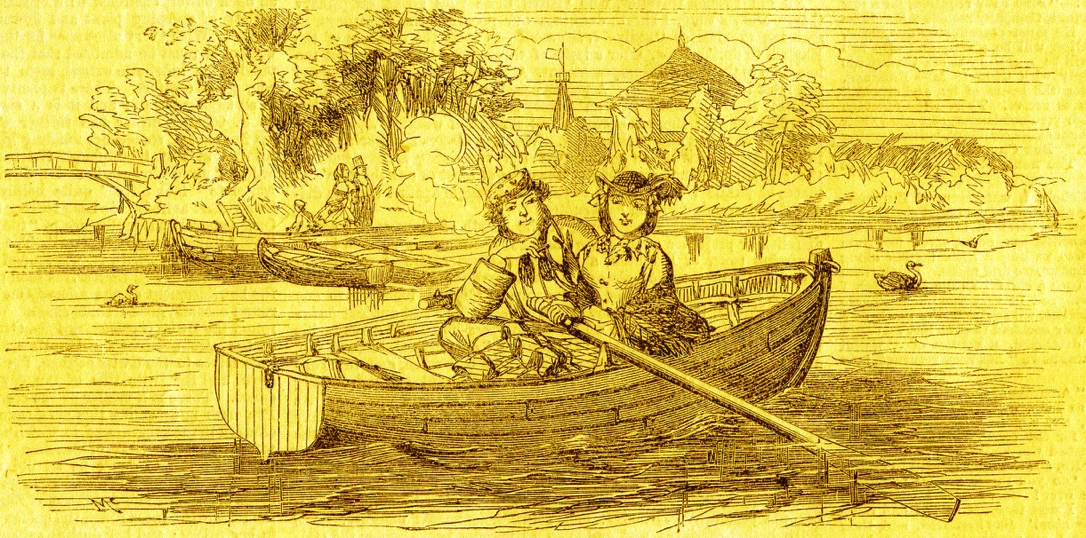
With every allowance for the vivid imagination of the synopsis writer, it must be admitted that the B. S and. his Adored One, multplied to an indefinite extent, seem to take their tea in the arbour, in very great comfort. There is plenty of hot water, laid on from spouts in an adjacent wall; and it is a sight for the sorest eyes to see the B. S. turning hither and thither with a teapot, sometimes burning his fingers and sometimes scalding his lavender inexpressibles;’ but he returns at last triumphant, the teapot smoking at the mouth, and orders “more shrimps” and unlimited bread-and-butter, telling the waiter to “look alive ” quite boldly, like a true and gallant British Sweetheart as he is. He has a trifling quarrel sometimes with the Adored One, generally with reference to “the short one in the round ‘at,” or “that bold thing in pink musling.” The A. O. deprives him of her parasol, and corrects him with it, whereupon he sulks; but he and the Adored One manage to lose themselves soon afterwards in one of the mazes to the bewilderment of the Adored One’s stout mamma, and at last come round corners, good friends again.
When the shades of ‘evening thickèn round the Swiss Gardens, and the German band threaten dire execution on the latest quadrilles and waltzes, then the B: S. and the A.O. betake themselves to the Swiss cottage, the Pavilion ball-room, or the velvet lawn, and the little tiffs of the day are forgotten in the exhilarating dance. There is a master of the ceremonies, grave and imposing: Am I in error in assuming this personage to be the author of the recondite effusion in the programme, in which we are informed that “The Ancients were remarkably fond of dancing. Socrates, who held death in contempt, learned to dance as an old man. Didius Julian, the Roman Emperor, had the celebrated Pylades to dance before him on the night of his election. The daughters of Shiloh danced in the solemn festivals; the Israelites danced round the golden calf; our gracious Sovereign dances in her palace; and her dutiful subjects will dance on this occasion at the Swiss Gardens all the day and all the night to improve their health, strength, and activity.
With all my heart, I am sure I told you there was a theatre in the Gardens, and a very neat and commodious one it is. It contains boxes, pit, and gallery; but “first come first served” is the rule as to placing the audience. From four to five some pretty dissolving views are exhibited on a screen by the “spirited proprietor “—to give him his time-honoured name—Mr. Goodchild; and shortly after, six theatrical performances commence. Here is the programme of one of them, a musical interlude, entitled—
OUR FOREIGN RELATIONS.
Mr Benjamin Briton (a true born Englishman) ……Mr. Hazlewood
Jemima Jenkinson (a sentimental young lady) … .Mrs. W. Cooke !
Carlo Petronella (an Italian boy) …..Mrs. W. Cooke ! !
Madame Chatterini (a French lady) …..Mrs. W. Cooke ! !!
Incidental Music to the piece—
Medley Song ……Mr. Hazlewood.
“The World’s Fashion” ….Mrs. W. Cooke !
“I’m so Nervous” ….Mr. Hazlewood.
“I came Across the Sea” ….Mrs. W. Cooke !!
“Beware my Vengeance ” ….Mrs. W. Cooke !!!
“Woman” ….Mr. Hazlewood.
Finale ….MR. HAZLEWOOD, MRS. W. COOK!!!!
Wonderful Mr. Hazlewood ! Astounding Mrs.W. Cooke! I should not be at all surprised to hear that Mr. Hazlewood wrote the piece and painted the scenery, and that Mrs. W. Cooke composed the music, and made her own dress. Surely there must be magic in the name of Goodchild, and all the employes of the Swiss Gardens must be descendants of that “Francis Goochild,” the industrious apprentice, who was Lord Mayor in Mr. Hogarth’s time.

These are not all the attractions of the Swiss Gardens. There is a “ladies’ swing” and a “gentlemen’s swing,” a cosmorama (slightly resembling a wine cellar), with views of the Holy Land, and of Dryburgh, Chatsworth, and Kirkstall. There are comic figures and fairy chromatropes ; there is a photographic gallery, an American bowling saloon, a ” roundabout for children,” a rifle-gallery, and at the western extremity of the gardens, a beautiful parterre of flowers, bounded by a handsome conservatory, blushing with hollyhocks, geraniums, fuschias, and “cream of tartar.” Yea, also, and in the Floral Temple of the Muses — the scene depicted in our principal engraving — there is a fountain playing real water, and flanked by a model of the Koh-i-noor in a gilt cage, and a silver fir in a Wardian case. There is also an observatory, which is in appearance very much like either a Brobdignagian wheatsheaf, or a stack of scaffold- poles; and finally, in a shed of remarkable construction—in which the early English seems combined with the recent railway station—there is the “Museum,” where, among other things, I saw the backbone of a shark, a Hindoo idol, the tusk of a walrus, and the effigy of an owl looking impenetrably wise.
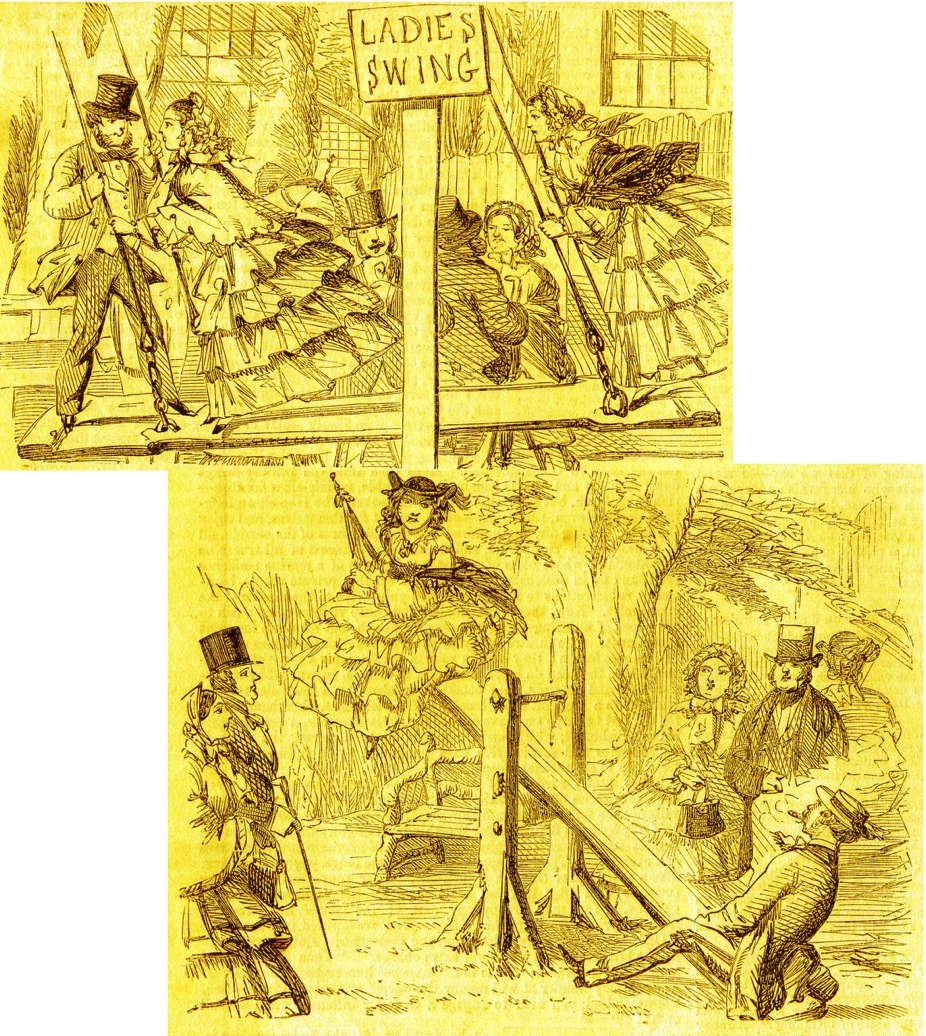
As I wander through these pretty, unpretending grounds, watching the romping children, looking at the giggling, blushing girls, indulging in the pastimes of the swing or the “see-saw,” listening to the gay music, viewing the cheerful parties enjoying the wholesome and cheap refreshments, whose supply (though not limited within teetotal principles) is a really praiseworthy feature in the management of these gardens, dancing, laughing, flirting if you will, but still, to all human seeming, thoroughly enjoying themselves— a feeling of bitter shame and regret comes over me, that in our boasted London we are all but destitute of such places of harmless, cheerful recreation.
There are the parks, you will say. Are there swings and roundabouts, a room for dancing, a peep-show or two, and hot water and shrimps for tea in the parks ? There is Cremorne ; but will Cremorne supply the want we feel—the want of an afternoon summer garden, where we don’t want to see “ life “ or “have a spree,” but where we want to have green grass for our children to play on, tables where we can sit over our cigar and coffee, our cigars and whatever we desire to call for in moderation, an orchestra to play enlivening music, a convenient space for a cheerful dance ? Why have we no Pie Catalan, no Thiergarten, no Champs Elysees, in London ? Why must we wait till night, and keep bad hours and worse company, before the enjoyment of the garden commences? These little Swiss gardens at Shoreham are humble enough in their way; but I declare, were I a despot or a magician, that I would transport them bodily to this overworked, overpeopled metropolis, as a model of a place of rational amusement, indulged in and conducted with unvarying good temper, and with admirable decorum.
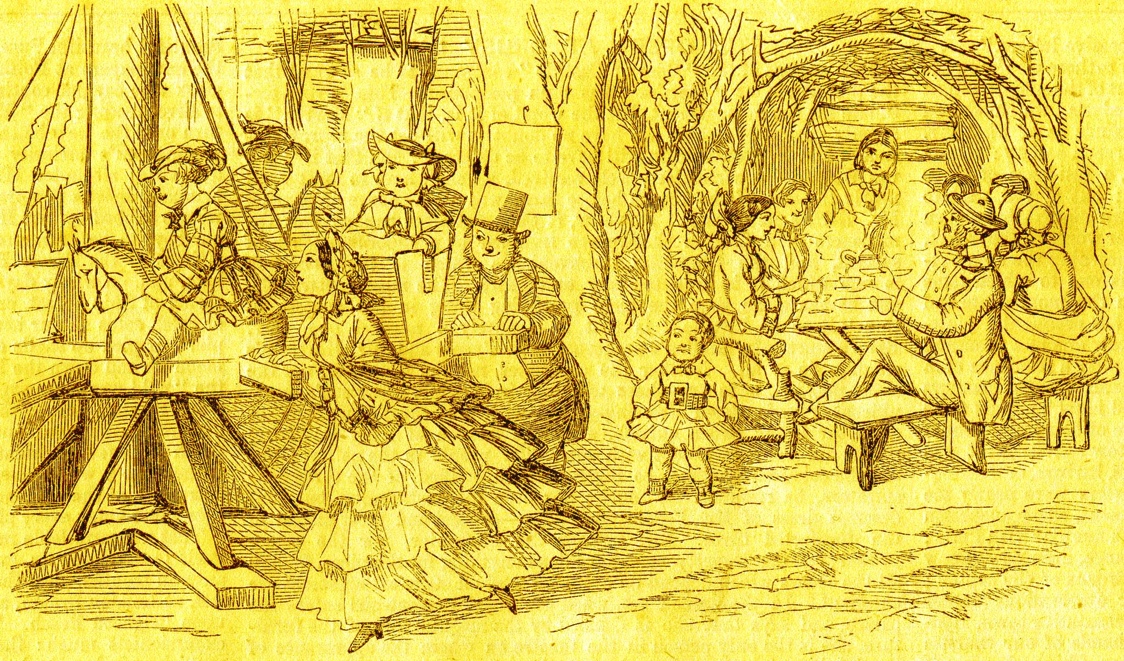
Illustration Acknowledgements:-
1. Detail from 1872 map at West Sussex Records Office
2. Author’s collection
3. Detail from Sussex Archaeological Society (SAS) image PP_SHORM_89.1323
4. Winton Collection
5. Doris K. Steers Collection
6. SAS image PP_SHORM_91.1728
7. SAS image PP_SHORM_02.3265
8. SAS image PP_SHORM_96.2806.2
9. Winton Collection
10. Peggy Bailey Collection
11. SAS image PP_SHORM_89.1002
12. Winton Collection
13. Author’s Collection
14 to 17. Sketches included with the 1858 Illustrated Times article
